At the 2022 D23 Expo, Chairman of Parks, Experiences, and Products Josh D’Amaro was on hand to unveil the roster of projects that would roll out across Disney Parks for the ensuing half-decade. Especially given the three year lapse since the previous D23 and the catastrophic fallout of the pandemic, the event was expected to serve as a venue for (re)announcements, status updates, and – hopefully – the eagerly-anticipated reveal of the next wave of mega-projects earmarked for the parks to power their post-pandemic recovery.
Strangely, practically nothing unknown of significance was revealed at the event, perhaps owing to then-new CEO Bob Chapek‘s expressed preference for high-yield merchandise, low-risk meet-and-greets, inexpensive IP overlays, and the focused machinations of the cross-promotional “synergy machine” and “franchise flywheel” he often, awkwardly spoke of. Chapek’s vision positioned Disney Parks as elaborate “brand loyalty centers” where Disney + Pixar + Marvel + Star Wars can be readily consumed – something nearly every then-recent addition to California Adventure had been evidence of…
Maybe that’s why the park eked out two quasi-announcements…
2023 – San Fransokyo Square
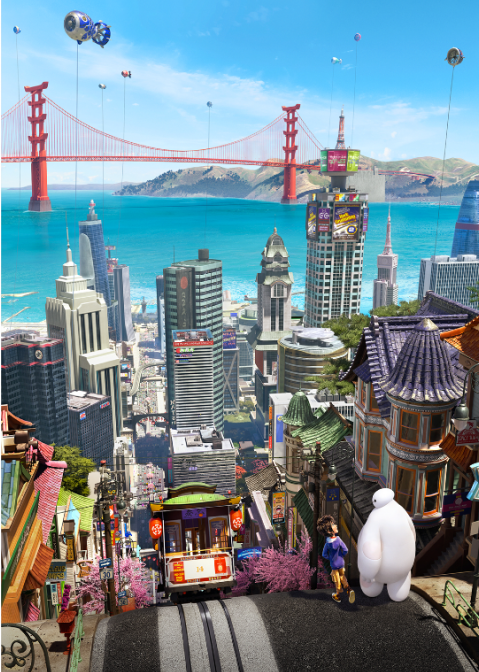
Just as the hefty price tag of Pixar inspired Disney to dig deep for ways to utilize the studio’s characters, the 2014 animated film Big Hero 6 actually originated from an all-call to find relatively unknown characters and stories in the Marvel canon that could be adapted across Disney’s studios. The Academy Award-winning film focuses on the story of teenage tech whiz Hiro Hamada and his inflatable “healthcare companion,” Baymax, as they inadvertently get caught up in a supervillain’s schemes and turn a ragtag group of college kids into a team of high-tech heroes.
Compelling as the film and its cast are, there’s no question that one of the movie’s standouts is the world it takes place in: the city of San Fransokyo – a sort of multiversal, near-future-set fusion of California’s already-eclectic Bay Area with Japanese-inspired architecture, culture, cuisine, and superhero-tech. This multiversal variant of San Francisco has a history all its own, beginning with the real 1906 earthquake that struck the city, causing cataclysmic damage. In this alternate reality, it was Japanese immigrants who set to work, using Eastern architecture and engineering to stabilize the city and set San Fransokyo on a new course, becoming a technological centerpiece of the globe.
A dynamic, electric, retro-futuristic pop metropolis, San Fransokyo is a vibrant coastal city of skyscrapers, tethered floating wind turbines, cherry blossoms, historic trolleys, Shinto shrines, LCD screens, and advanced laboratories maintained by students of the San Fransokyo Institute of Technology. Rich, cultural, and cutting-edge, Big Hero 6 presents San Fransokyo as a vast and exciting world.
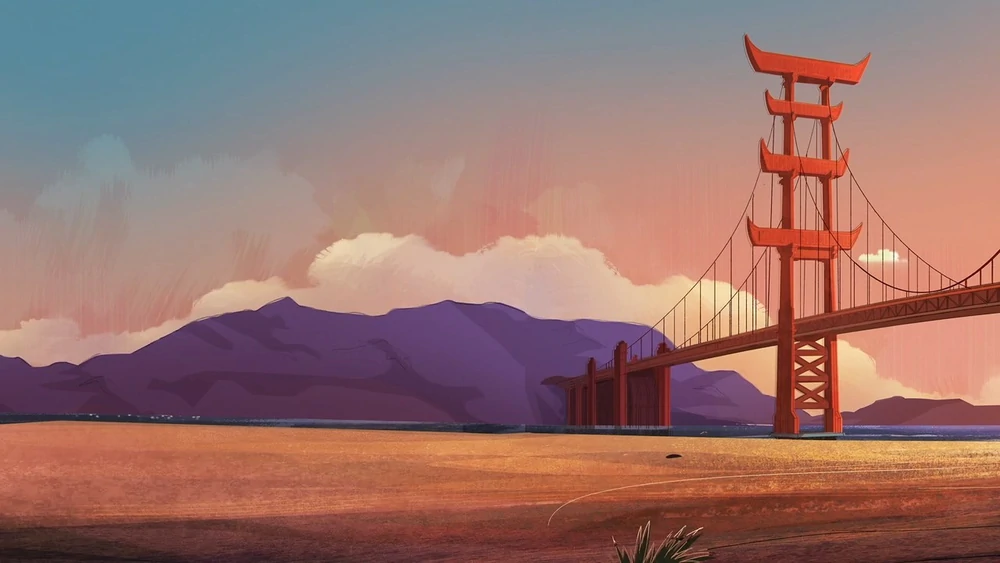
And frankly, San Fransokyo would make for a fantastic land at California Adventure – a modern-day, IP-washed version of the Possibilityland: Discovery Bay, serving as the park’s equivalent of a comic-book-infused cityscape mixed with the plucked-from-the-screen style of Cars Land. Highly distinct, highly diverse, and highly Californian, San Fransokyo has all the makings of a good fit for the park – rich, textured, cultural, historic, idealized, and filled with character.
For that reason, fans might’ve been momentarily stunned when – at the D23 Expo in 2022 – Josh D’Amaro almost casually breezed by the announcement that a new San Fransokyo land was en route to Disney California Adventure.
Especially for Park Lore readers (who hopefully saw my plans for a fully-immersive Big Hero 6 land as part of my from-scratch concept park, Disney’s Fantastic Worlds) San Fransokyo conjures images of a Cars Land-scaled expansion anchored by a KUKA Robo-arm dark ride sending guests flying through the streets alongside the Big Hero 6 team. In other words, it sounded like a windfall for the park… until D’Amaro revealed the art.

In a breath, D’Amaro announced that San Fransokyo would merely be a light restyling and renaming of the park’s existing Pacific Wharf – an area that had been a part of California Adventure since its opening. Back in 2001, Pacific Wharf had been one of the visual stand-outs in “DCA 1.0” thanks to its coastal warehouses (recalling Monterey’s Cannery Row) and its myriad of international quick service eateries.
Even though it didn’t contain a ride (and didn’t have any space available to house one even if it wanted to), Pacific Wharf “graduated” to full “land” status as part of the park’s 2012 relaunch. Now, one of the few remaining untouched corners of California Adventure would receive its own mandated IP tie-in, renaming and re-stylizing itself after Big Hero 6.
(One grateful edit since the land’s announcement at D23 was that its name was changed from “San Fransokyo” to “San Fransokyo Square” – a simple but really necessary modifier that communicates that this space is not even trying to be the vibrant, sprawling, modern metropolis we saw in the film that it’s demonstrably not. Instead, San Fransokyo Square signals that this is just one small part of the city – its wharf – while the rest of San Fransokyo is just “off-screen” and out of our view.)
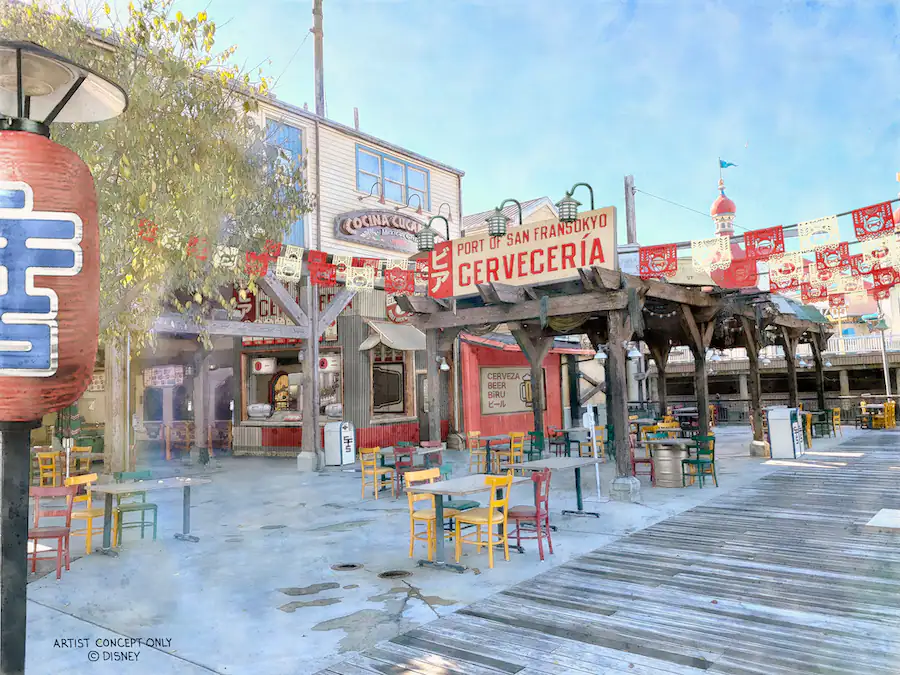
According to its WDI-required, in-depth backstory, San Fransokyo Square is meant to communicate a dense history for the wharf district of town; that as San Fransokyo’s fishing and canning industries dried up, tech moved in and “entrepreneurs came together to reinvent the bayside canneries into a vibrant, multicultural district of neighborhood restaurants and small businesses where you’ll be able to eat and shop.”
That also allowed the structures and restaurants of Pacific Wharf to be swirled into Disney’s favorite in-park aesthetic (adaptive re-use of abandoned warehouses) and its favorite in-park narrative du jour (that you’re visiting and supporting small, minority-owned businesses with their own embedded histories).
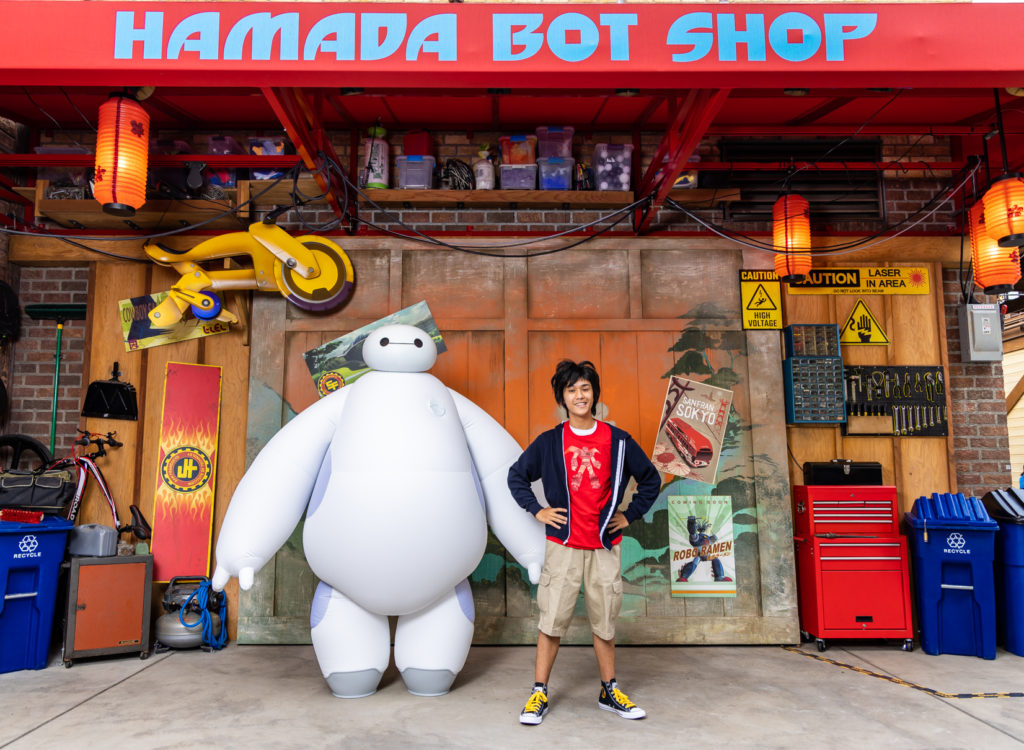
San Fransokyo Square, then, can retain Pacific Wharf’s Mexican and Asian quick-service eateries, its bakery, its chocolate shop, its beer garden, and its margarita stand, with just placemaking, the embedded backstory, a new “Maker’s Market” retail stall, and a Baymax meet-and-greet to provide anything of substance to the “reimagining.”
Still, one has to wonder: does stringing paper lanterns, playing J-pop music, and painting Japanese signage over a food court really embody San Fransokyo in any meaningful way? Cynics might argue that in this form, “San Fransokyo Square” is a “label slap” that only the Chapek regime could produce. Which is a real shame, because of all of the IPs you’ll find in Disney California Adventure, San Fransokyo is perhaps the first that really fits there.
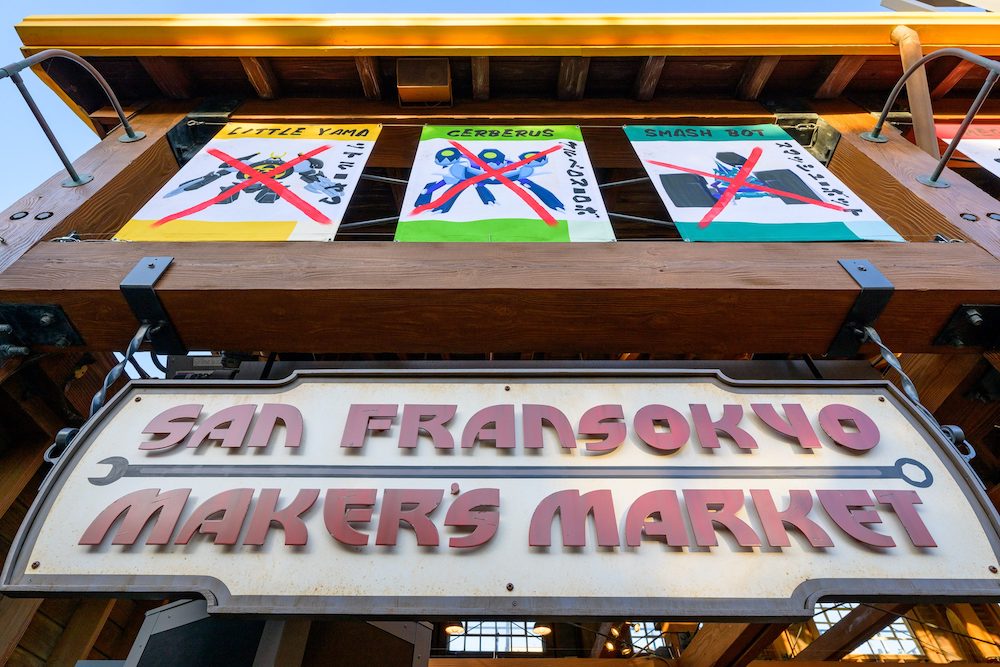
Like so much of “DCA 3.0,” its a land of extremes. San Fransokyo Square has the depth, texture, realism, “history,” color, and transportational quality that the park lacked for so long. It’s packed with new details, Japanese signage, countless “Easter eggs,” and of course, a whole lot of fun (see, Baymax-shaped sourdough bread).
But like Pixar Pier before it, it would be fair to critique the land as a minimum-effort overlay; a “quick fix” corporate mandate with no “long game” view; a “label-slapped” space that is, at its heart, “cute but dumb.” Though it’s incredibly dense and packed with props and placemaking , it would be fair to say that it all sort of amounts to just decoration.
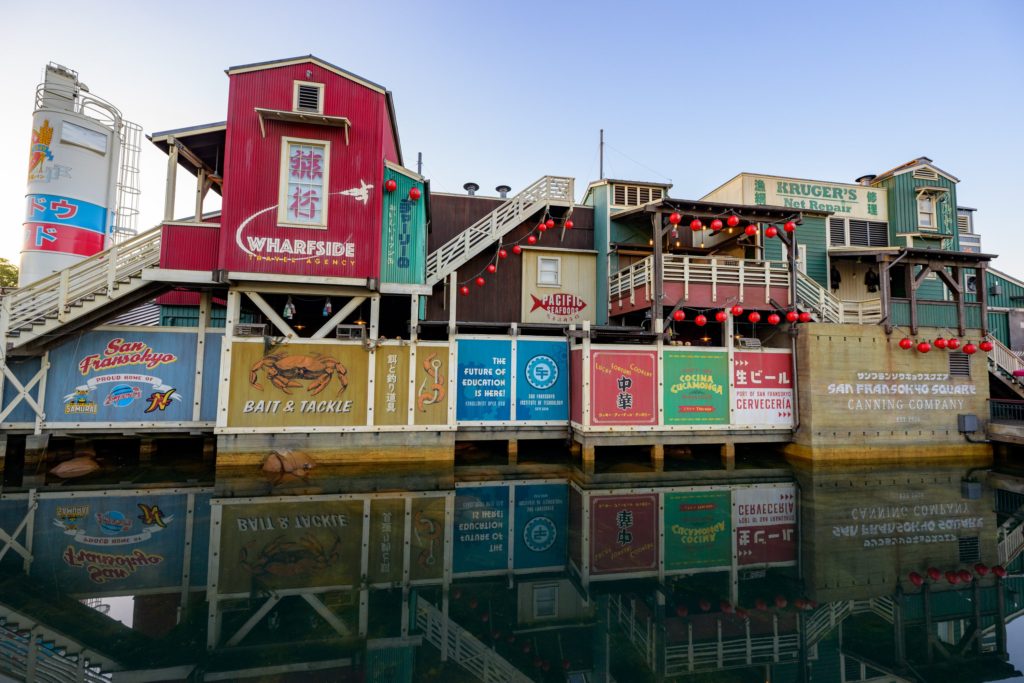
Ten years after Cars Land introduced the notion of a Disney theme park land meaningfully derived from and lovingly recreating a place seen on screen, San Fransokyo Square serves as something of an inversion on the formula. It wants to bamboozle us into thinking that maybe the place we saw in Big Hero 6 wasn’t so different from that area that already existed at California Adventure, so just some placemaking should do the trick to retroactively make this a “Living Land,” too.
Hey, it’s Instagrammable! It’s got great snacks, and fun Easter eggs, and lots of color! And like every other project to come from the “DCA 3.0” mindset, who would bother rejecting all that and pouting their way through San Fransokyo Square? Even if it’s “just decoration” and even if it doesn’t actually look like any part of San Fransokyo we saw in Big Hero 6, it benefits from the spirit and style and chaos and culture. It’s not like it’s a downgrade, and it’s not like Pacific Wharf was holy ground, after all.
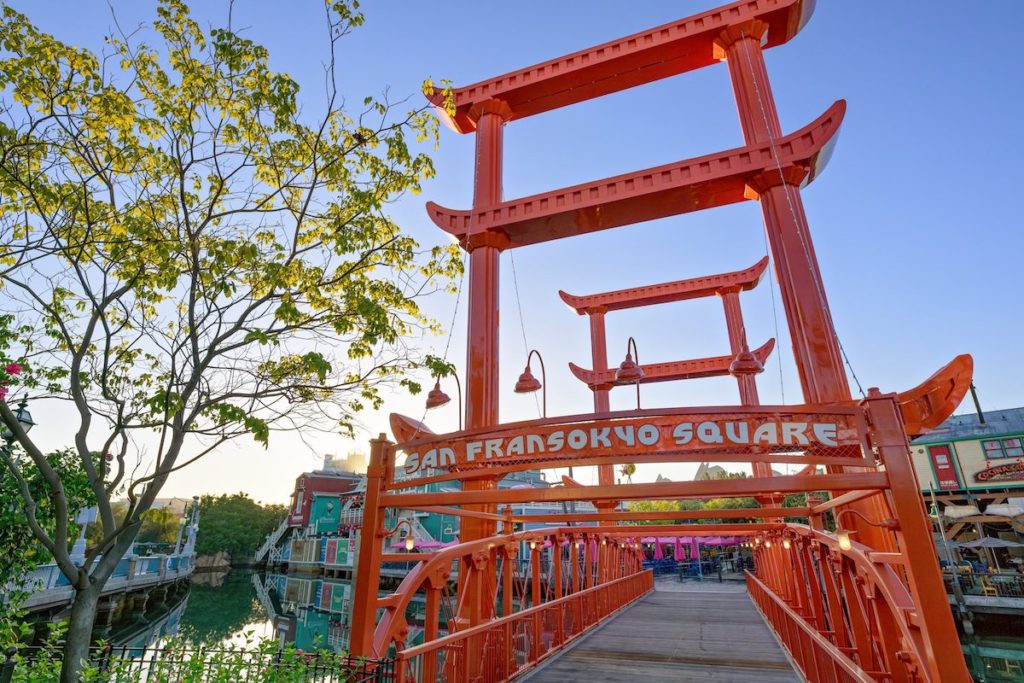
And by the way, if the primary complaint about DCA 1.0 was that it was “too much California, not enough Disney,” then certainly those critics have been silenced. To that point, one might argue that today’s California Adventure – “DCA 3.0” – is “too much Disney, not enough California.” A vast overcorrection, creating a park that – on paper – is a literal antithesis of its original self.
Of course, Horseshoe theory suggests that any two polar opposites aren’t really as far apart as they seem; that instead, on a given spectrum, the “extremes” tend to bend toward one another in surprising ways. It’s interesting to see that manifest in San Fransokyo Square where – as in so much of “DCA 3.0” – we see the faults of “DCA 1.0” anew. Richer and brighter and more historic and reverent and more texturized and wrapped in IP, of course…
But as in 2001, modernity is back in style; here, a comic book aesthetic is a good thing; here, modern pop music serves as an ambient soundtrack; here, we’re back to “DCA 1.0’s” aesthetic of reclaimed warehouses, low-cost overlays, and restaurants-over-rides. It feels a little too on-the-nose to point out that in an almost-jaw-dropping return to page 1, San Fransokyo Square includes as its entry a stretched-and-skewed, mis-proportioned, cartoonish, almost “toyetic” recreation of the Golden Gate Bridge – the very same that once served as the visual centerpiece of the park’s retired postcard entry.
But San Fransokyo Square wasn’t the only announcement for California Adventure at the 2022 D23 Expo…
202X – Avengers Campus, continued
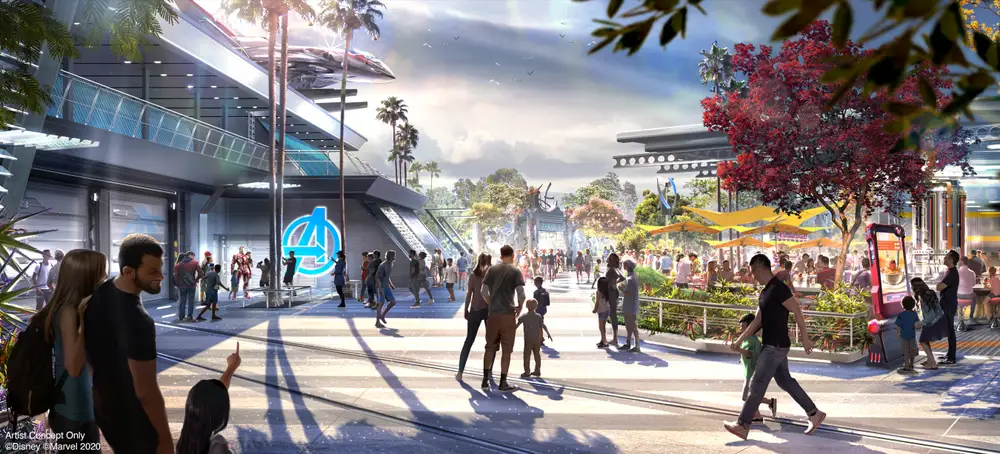
By 2022, few even bothered imagining that the Avengers E-Ticket Chapek had “soft-announced” three years earlier was still a possibility.
For many reasons, it makes sense that that ride was dead on arrival. For one, then-firmly-planted-CEO Chapek would no doubt balk at another Rise of the Resistance-level technological and financial investment post-COVID. But likewise, the 2020 death of Black Panther star Chadwick Boseman made the ride’s Wakanda focus untenable.
Plus, frankly, given the MCU’s breakneck pace, it would probably be unwise to set an anchoring ride so firmly in the “Infinity Saga” when Iron Man, Black Widow, Thor, and Captain America would star when the MCU has moved on to its next twenty-film arc, the “Multiverse Saga.” A headlining ride for Avengers Campus needed to not only harken back to the original heroes fans would never forget, but to embrace the unknown (and highly episodic) nature of the MCU going forward.

So it wasn’t incredibly surprising that revised concept art (above) axed the looming, white Avengers compound showbuilding and instead opted for an otherworldly, “Multiversal” purple mist obscuring the last of California Adventure’s sizable expansion pads.
Marvel Studios’ executive Kevin Feige dropped into the 2022 Parks Presentation to announce the land’s redeveloped (and unspoken: scaled back) Avengers ride. The new attraction would see guests encounter a Multiversal variant of the Infinity Saga’s legendary “big bad,” Thanos, with this version of the character arriving in Avengers Campus from an alternate reality where he successfully defeated the Avengers and conquered Earth, now setting his sights on our universe.
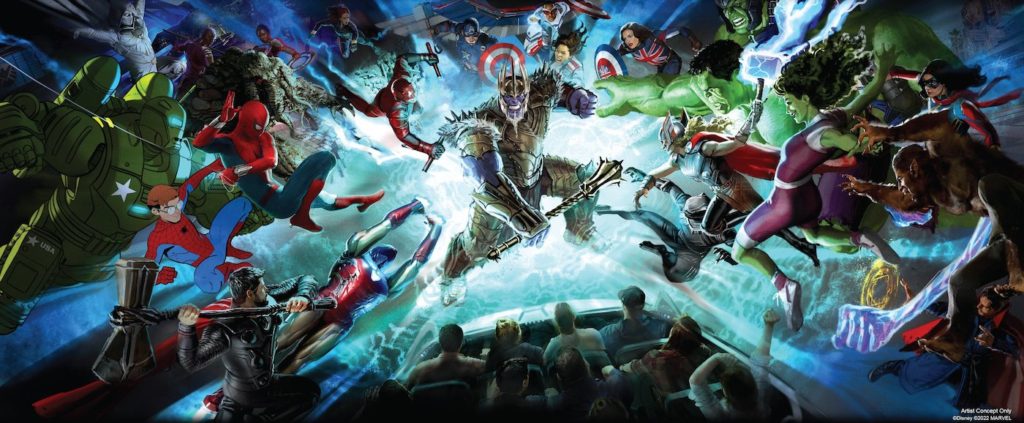
Chapek promised that heroes “from anywhere and any-when” would join the fight, as evidenced by the single piece of concept art fans were left to scour and scrutinize. In it, “Multiversal variants” from the MCU and adjacent universes – three Captain Americas, three Hulks, two Spider-Men, Daredevil, Moon Knight, and more – descend on “King Thanos” as riders look on.
But if Disney hoped that online chatter would focus on the apparent fan service of Multiversal heroes, they underestimated the focus of Imagineering aficionados which instead turned to – of course – the ride vehicle. Though discussion boards filled with ideas of what the ride vehicle – multi-rowed, four across – might be, Occam’s razor worked its magic.
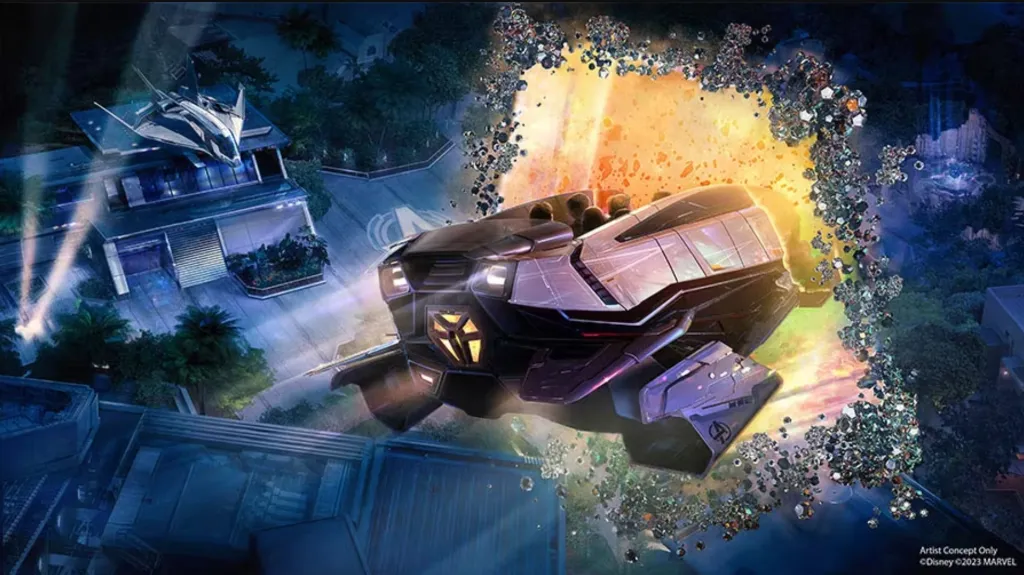
At the semi-annual Destination D23 mini-expo in September 2023, Imagineers released a second piece of concept art for the attraction’s “multiversal transport” – a fan service combination of Tony Stark’s time-suit tech (worn memorably by the Avengers in Endgame), Xandarian jump point hardware, and Wakandan innovation. But theme park adherents quickly recognized it for what it more closely resembled…
Yep. A quarter century after Universal had reinvented the modern dark ride with the Modern Marvel: The Amazing Adventures of Spider-Man, Disney would finally apply its version of the “SCOOP” ride system for (ironically enough) its own Marvel super hero adventure. That’s not to say that the new ride couldn’t be a headliner in its own right… but certainly, the notion of a mostly screen-based, motion-simulating family dark ride felt like an odd “downgrade” when fans had once been promised jet packs and a larger-than-life thrill ride defined by groundbreaking technology and KUKA Robo Arms.
… But hold that thought.
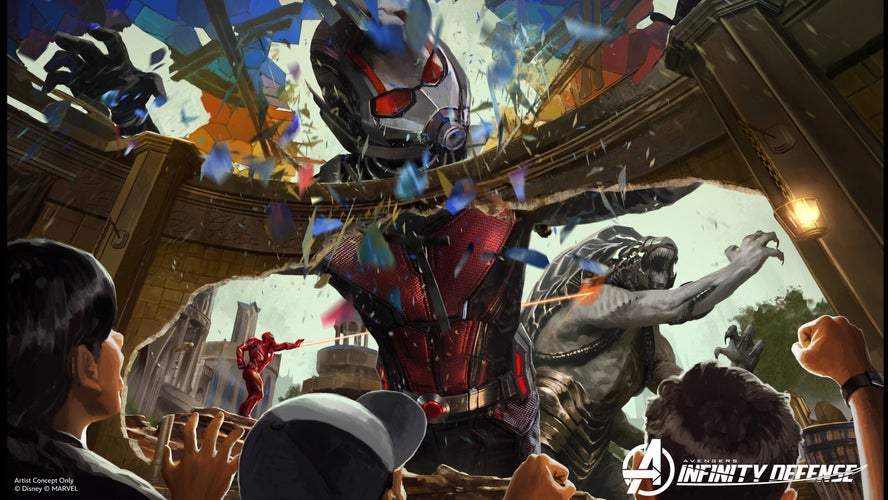
By the 2024 D23 Expo, ground still hadn’t moved on the Avengers E-Ticket that had been re-introduced two years earlier after having technically been announced three years before that. But among Parks Chairman Josh D’Amaro’s promises that this time, everything he discussed would be a real, actual project that was “actually happening,” fans we did learn the name of the new attraction – Avengers: Infinity Defense. (A somewhat stoic and passive name, perhaps, but smartly, severing the ride from the lukewarm “Multiverse Saga” and avoiding any mention of the “Multiverse” this time around.)
In this latest revised description, fans were only promised that they’d pass through “jump points,” chasing King Thanos between MCU locales like Asgard, Wakanda, and New York City, apparently recovering each from being erased by Thanos’ attack. Okay, so as of now, it doesn’t seem like Avengers: Infinity Defense will be the showstopping, jaw-dropping, industry-changing thrill ride we wanted for California Adventure… but we can at least cross our fingers that this ride incorporates a few surprises along the way. Speaking of which…
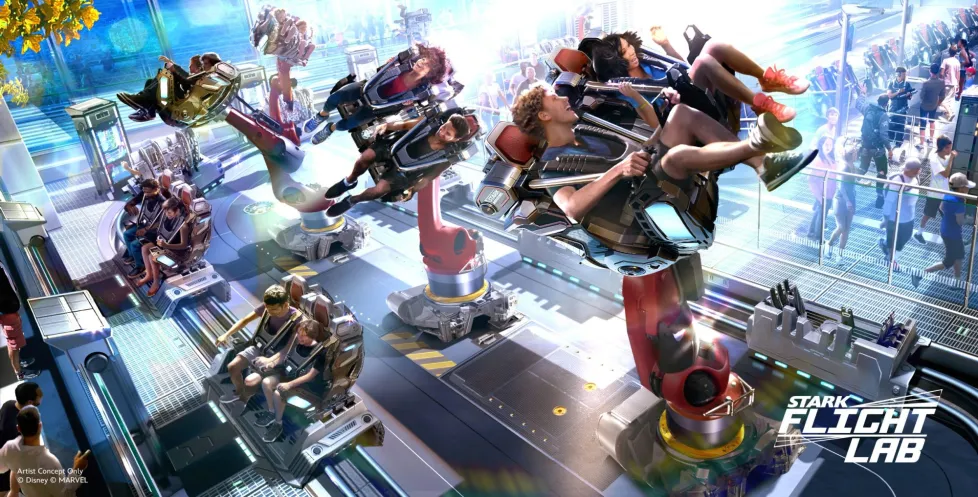
In a surprise announcement few expected, the 2024 D23 Expo also included the unveiling of a second ride earmarked for Avengers Campus. Stark Flight Lab will be an unusual new technological flat ride. Apparently, guests will load into two person jetpack pods affixed to a rotating conveyer belt. Then, they’ll align with Stark-branded robotic arms (such as you might see in an automobile assembly plant) that will grasp the pod, pick it up from the ground, and proceed through a “flat ride” cycle of spins, drops, flips, and “dancing.” When it’s all said and done, the arms will return the pods to the conveyer belt, to be whisked back to the load area.
As much fun to watch as it’ll be to ride, Flight Lab looks to be a clever, high-tech twist on a standard flat ride that smartly blends into both “layers” of the Campus’ narrative (that it’s an old auto manufacturing facility, and that it’s a place to test out new hero tech in a laboratory-like setting) while adding a seriously ambitious tech element and a sincere thrill-seeker draw to the land. (And okay, if you’re a conspiracy theorist like we are, it’s a way for Disney to fulfill a contract with KUKA for hardware that was meant to be part of the original E-Ticket…)
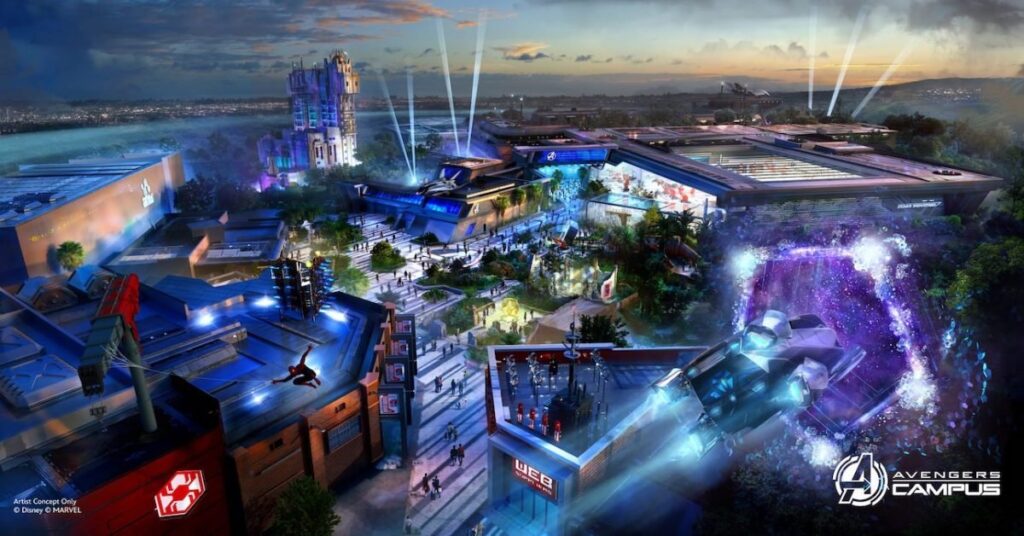
When it opened in 2021, Avengers Campus was criticized for its lack of action and its relatively small attraction count. There’s no question that this long-awaited “Phase II” expansion should change that perception. When it’s all said and done, the land will contain Guardians of the Galaxy – Mission: BREAKOUT!, Web Slingers: A Spider-Man Adventure, Stark Flight Lab, and Avengers: Infinity Defense…
On paper, that’ll just recover the four rides that were lost with the closure of “a bug’s land” – and by the way, it’ll come at the cost of the Red Car Trolley that served as such an icon of California Adventure’s rebirth. But importantly, it’ll create a genuinely ambitious ride lineup for this relatively tiny space – a drop tower, an interactive family ride, a technological flat ride, and an E-Ticket dark ride. That at least feels much closer to the attraction collection that Marvel deserves. And unbelievably, that was just the appetizer to California Adventure’s 2024 D23 announcements… Read on…


